Like other major American cities, Baltimore has its fair share of tall towers, most of which are clustered downtown around the Inner Harbor. These vertically inclined structures, however, are really more versions of what used to be called “skyscrapers.” Look past the gridded facades of concrete, glass, and steel – slowly obliterating the historic buildings of downtown Baltimore – and wander farther into the city, beyond the boutique stores and tourist traps of the waterfront. Here and there you will discover a host of humbler, more endearing towers, popping up throughout Charm City like exotic little mushrooms.
Towers are important landmarks in the story of architecture, a part of its history and mythology. From the Biblical Tower of Babel to the former Twin Towers of the World Trade Center in New York City; and from the Leaning Tower of Pisa to the Eiffel Tower in Paris, towers persist as unique features of the built environment and enduring symbols of the human imagination. Drawing our eyes skyward, they exemplify the hopes and dreams of civilization, while also suggesting the ever-watching authority of the powerful elite. Depending on their context, in other words, towers may be utopian or dystopian. The Sky and Space Needles found in cities around the world (Brisbane, Calgary, Seattle, Toronto) speak to humanity’s aspirations and ideals, whereas the guard towers of concentration camps and prisons remind us of their darker, more authoritarian functions.
While there may be some debate over what constitutes a tower, for the purposes of this piece I will limit the term to mean: a) any freestanding, human-made building that is taller than it is wide; b) a building in its own right and not a feature of a larger structure like the turret of a castle; c) something that can be entered and ascended (that is, not simply a column or obelisk); and d) not a corporate high-rise. Since moving here several years ago, I’ve become enchanted by six such towers: the Patterson Park Pagoda or “Observatory” in Southeast Baltimore; the Phoenix Shot Tower in Jonestown; the Emerson Bromo-Seltzer Arts Tower downtown; the Washington Monument in Mt. Vernon Place; the Moorish Tower at Druid Hill Park; and the “Candelabra” Tower on Television Hill. These six towers meet the criteria outlined above and provide a healthy sample of the towers of Baltimore.
The Patterson Park Pagoda or “Observatory”
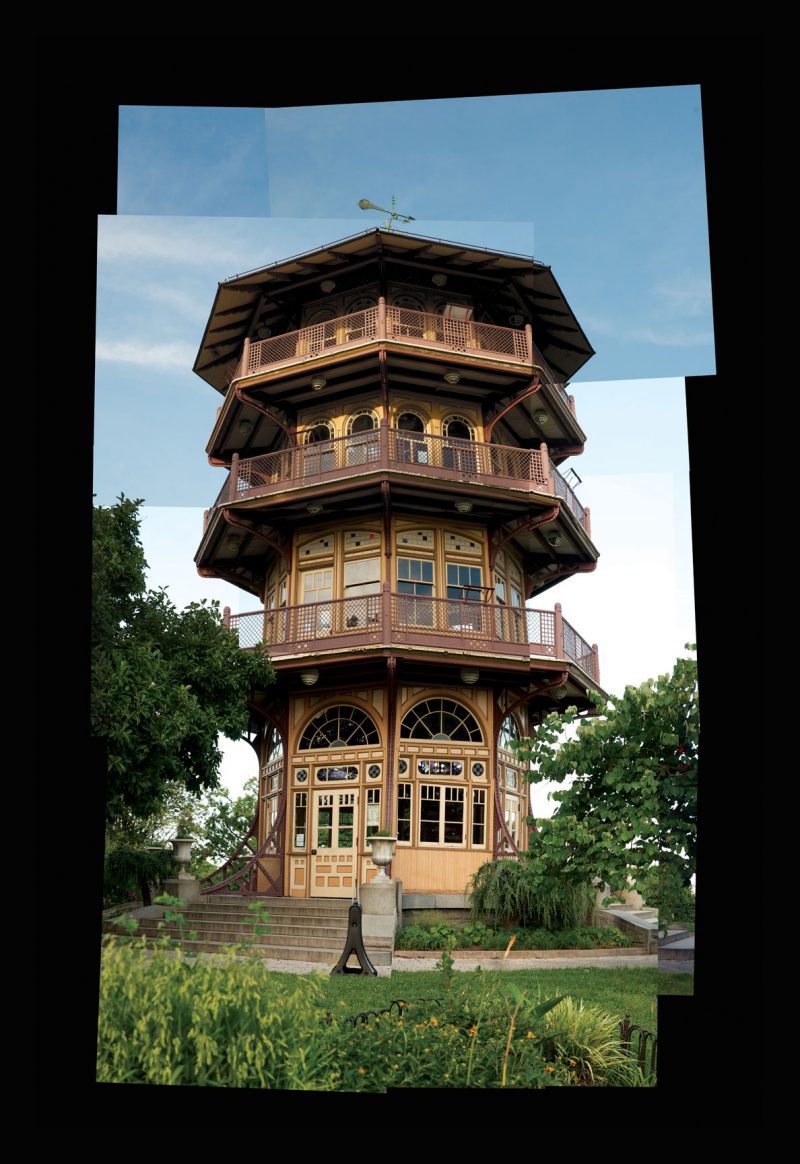
Photomontage by Dereck Stafford Mangus
The Victorian-era tower at the top of Patterson Park in Southeast Baltimore is a good place to begin. Built in 1892, the “Observatory” is perhaps the most aesthetically pleasing of the group. While inspired by the Asian architectural model, its decoration and materials are clearly Western. Like the Eiffel Tower in Paris, the naked steel structure of the “Observatory” harkens back to a time when such materials suggested the triumph of industry and progress. One of the best views of Baltimore is afforded to those who ascend the four-storey spiral staircase to its top deck. There, one can take in the high-rises of downtown Baltimore, Ft. McHenry, and parts of the Inner Harbor.
The Phoenix Shot Tower in Historic Jonestown
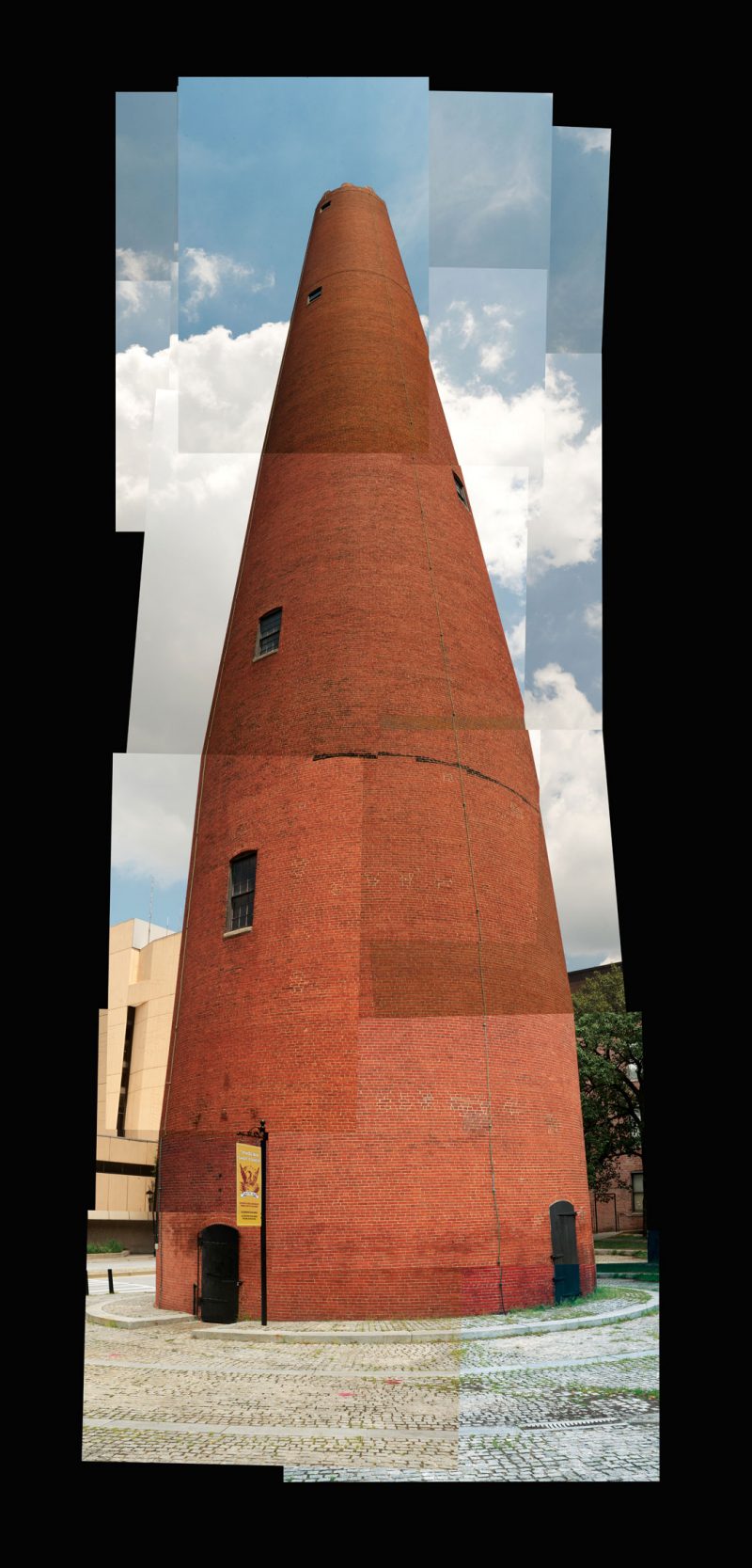
Photomontage by Dereck Stafford Mangus
If the Patterson Park Pagoda celebrates aesthetics over function, the Phoenix Shot Tower a mile-and-a-half west, represents the exact opposite. The original purpose of this unadorned brick building was to produce “drop” shot, which is used in small game hunting. Molten lead, poured through colanders at the top of the tower, spun and cooled as it fell through the air before landing in a large container of water at the tower’s base, forming “perfectly globular” spheres of shot. This process was used until the late-nineteenth century when newer methods made the tower obsolete. Built in 1828, the Phoenix Shot Tower in Baltimore was the tallest building in the nation until 1846. More recently, it was converted into a historic landmark, owned by Baltimore City and run by the Carroll Museums.
The Emerson Bromo-Seltzer Arts Tower in Downtown Baltimore
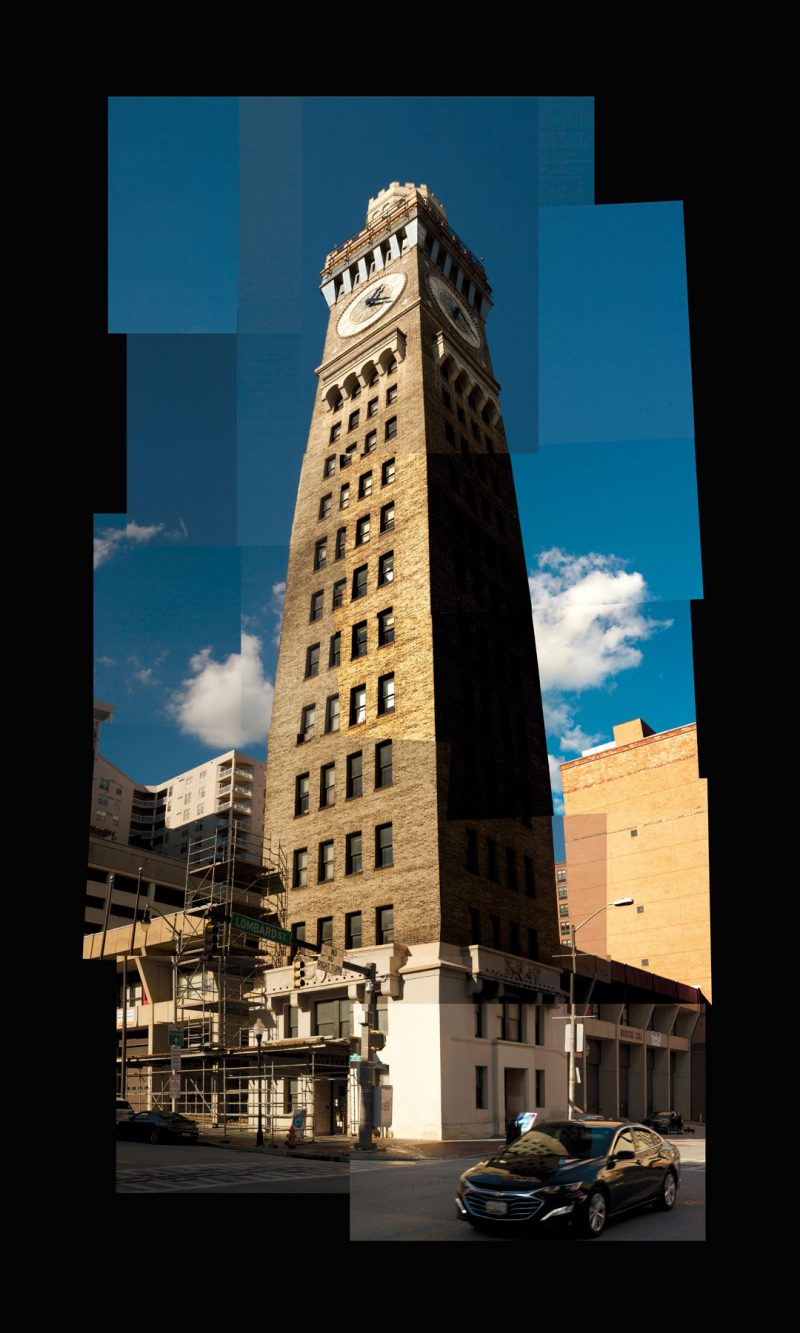
Photomontage by Dereck Stafford Mangus
First known simply as the Emerson Tower, named after its creator and the inventor of the popular headache remedy, Captain Issac Emerson, this tall edifice is one of the last remaining historic buildings in downtown Baltimore. Erected in 1911, the landmark tower is listed on the National Register of Historic Places, and was inspired by the Palazzo Vecchio in Florence, Italy. It was originally part of a larger complex that served as the headquarters and manufacturing plant for the Emerson Drug Company. The buildings around it were later razed to make room for a modern fire station. Thankfully, the tower was preserved, though an oversized seltzer bottle that used to glow blue and rotate atop the tower was removed. The clock, which uses the letters BROMO-SELTZER instead of numbers, and the elevator still work. In early 2007, after being abandoned for several years, the tower was remodeled by the Baltimore Office of Promotion and the Arts to house artist studios and exhibition spaces.
The Washington Monument in Mt. Vernon Place
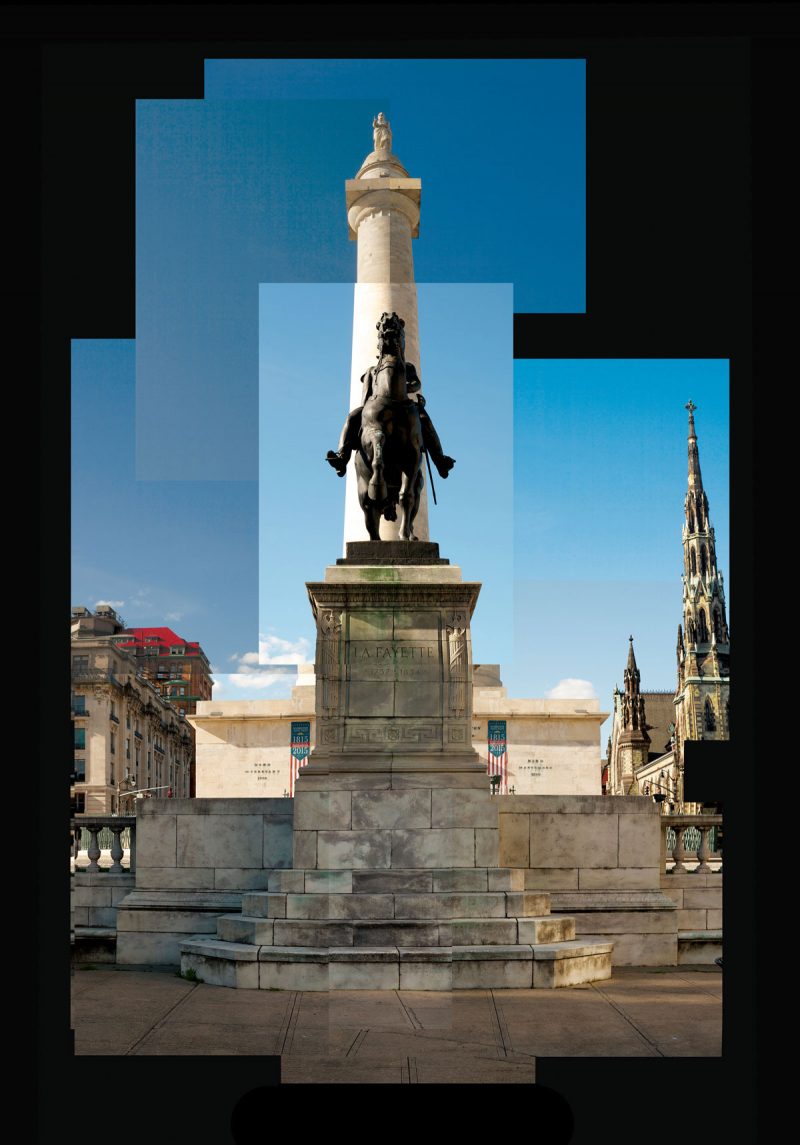
Photomontage by Dereck Stafford Mangus
Anyone walking through the historic neighborhood of Mt. Vernon in Baltimore will be impressed by this massive column, which declares itself like a gigantic white marble exclamation point at the center of Mt. Vernon Place. Unlike its later, much larger (and more famous) Egyptian Revival counterpart in D.C., Baltimore’s neoclassical tribute is topped with a larger-than-life statue of the man himself, America’s first Commander-in-Chief, facing south towards the Inner Harbor. Letitia Stockett writes in Baltimore: A Not Too Serious History, “All Baltimoreans are born under the shadow of Washington’s hand and from a hundred different angles we shall see the marble shaft rising against the sky.” It is the first such landmark in the nation and provides an excellent view of the surrounding area to anyone not too claustrophobic to climb the tight, spiral staircase within the column.
The Moorish Tower at Druid Hill Park
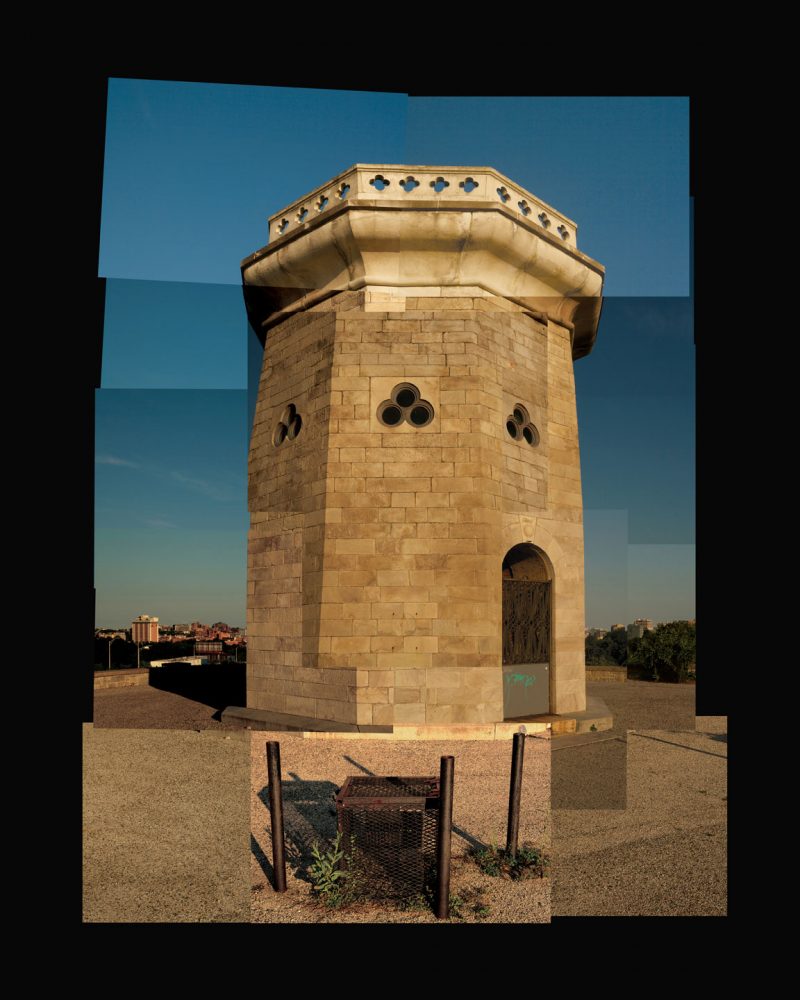
Photomontage by Dereck Stafford Mangus
Moving north from Mt. Vernon, we make our way to where the Moorish Tower stands guard beside Druid Hill Pond. Looking like a solo rook on a deserted chessboard, this tower exemplifies what is referred to as a “folly,” meaning a building constructed for decoration. Follies began in eighteenth-century English and French landscape design as the Romantic taste for ruins became fashionable among the landed gentry. These fake relics were meant to enhance the “picturesque” style that replaced the earlier, more geometric garden designs like those found at Versailles outside of Paris. Like the Patterson Park Pagoda, the Moorish Tower at Druid Hill Park was originally designed as a lookout point, allowing visitors a view of downtown Baltimore from the north. Over the years, the tower fell into disrepair and the rusted iron staircase within became a safety hazard for visitors. So, after some renovations, the city sealed off the entrance, but left the eccentric building standing. People still like to walk or ride their bikes up to the Moorish Tower as a great vantage point to take in the industrial sublime that is Baltimore.
The “Candelabra” Tower on Television Hill
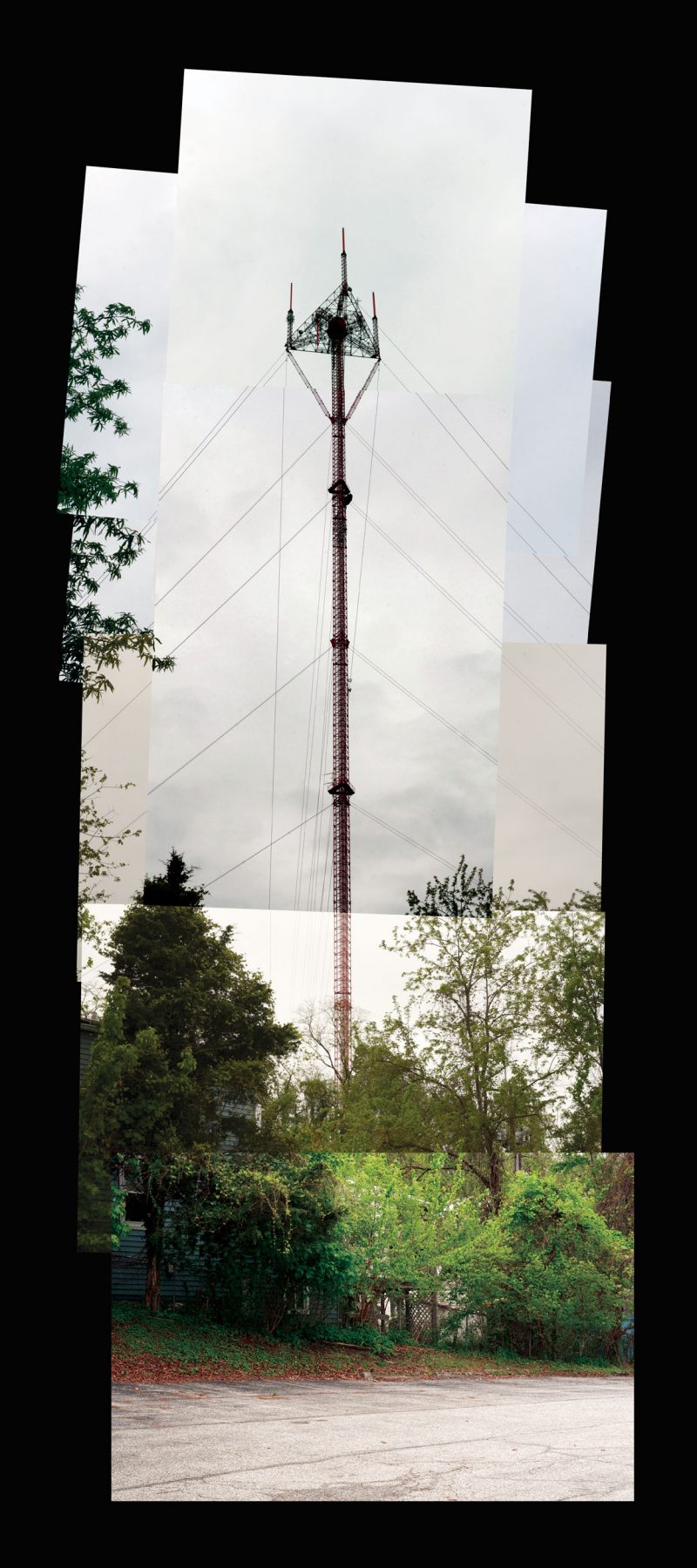
Photomontage by Dereck Stafford Mangus
The “Candelabra” Tower on Television Hill is the structure that diverges most from the list. For one, it is not freestanding: guy-wires hold it erect. An elevator allows workers to maintain and repair it, but is inaccessible to the general public. Neither the sole – nor even the tallest – tower on Television Hill (it shares the area with several other antennae), the “Candelabra” Tower is easily the tallest in my group of six. Named for its triangular crown of blinking lights, it casts a sinister vibe over Charm City. Nonetheless, the “Candelabra” is the one tower that connects all six through its transmission of radio waves, light waves imperceivable to the human eye. All day and night, the “Candelabra” Tower on Television Hill in Baltimore fills the sky with invisible lightwaves, washing over the city with the disparate voices of local radio and television stations like an electronic Tower of Babel.









